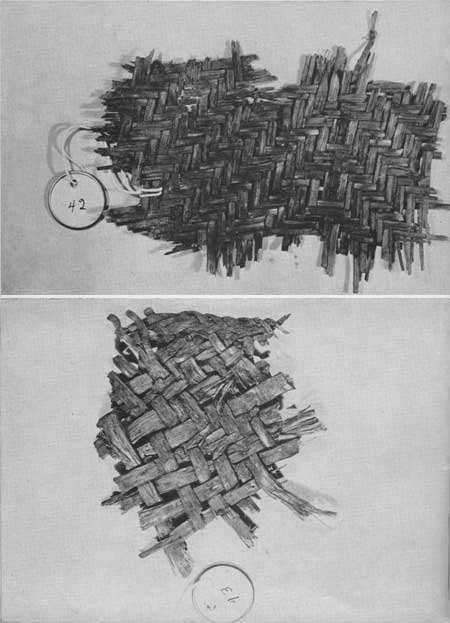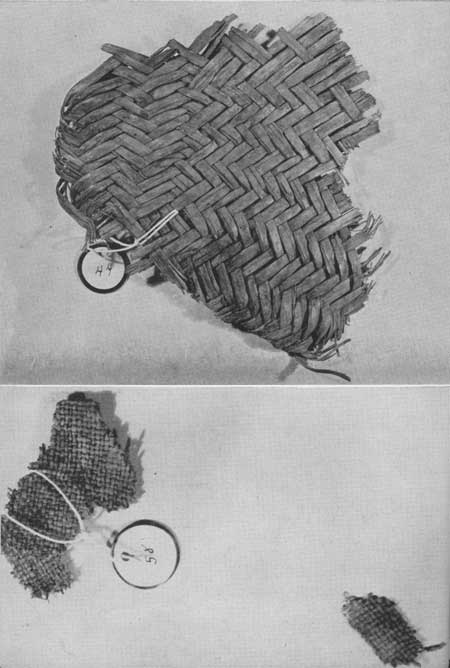|
MONTEZUMA CASTLE
Montezuma Castle Archeology - Part 2: Textiles |

|
MATTING
(Nos. 42, 43, 44, 58)
There are four small pieces of matting among the specimens. Nos. 42 and 44 are of Dasylirion wheeleri; No. 43 is of Yucca mohavensis; and No. 58 is of Juniper bark.
The two Dasylirion specimens are an over-three, under-three twill, the weaving elements being broad flat twigs. No. 44 shows the warps and wefts doubled on themselves at the edges of the mat, and carried back into the weave. The method of manipulating the weave elements in this piece changes the direction of the chevron produced in twilling, and a simple design results. Similar specimens are described in Haury (pp. 81, 82, Fig. 14).
No. 43 is so battered that it is impossible to say exactly how the twill proceeded. It evidently had a border made by splitting the weave elements in half near the edge of the piece and twilling the halves together. It is similar to Haury's fig. 15 (p. 83), but in such poor condition that no absolute technique can be determined. No. 58 is composed of two tiny fragments of fine checker weave.
Specimen 42. Matting
Maximum length: 5-3/4"; 14.8 cm.
Maximum width: 3-3/4"; 9.6 cm.
Width of plaits: 1/8"; .3 cm. to 3/16"; .4 cm.
Material: Dasylirion wheeleri.
Weave: Mat (Cf. Haury, pp. 81-82, and Pl. LIV; Hough, Pl. 16.) Twilled from flat fibers. See drawing. No border remains.

|
| Figure 40 |
Specimen 43. Matting (PS No. 6)
Maximum length: 4-1/4" 10.8 cm.
Maximum width: 3-1/4"; 8.3 cm.
Width of plaits: 3/16"; .4 cm. to 1/4"; .6 cm. Width of border: 3/8"; 1 cm.
Material: Yucca mohavensis.
Weave: Mat (Cf. Haury, pp. 81-82, and Pl. LIV.) The piece is so fragmentary that reconstruction of the technique, particularly that used for the border, is nearly impossible. The flat fibers were probably woven over-one under-one. As nearly as can be determined, the border was made by splitting some of the fibers in half near the edge of the piece, and twining these halves together. Other weave elements were simply cut off at the border, and not employed in it. (See drawing.)

|
| Plate 47. Matting, Specimens Nos. 42, 43 |

|
| Figure 41, Specimen 43 |
Specimen 44. Matting
Maximum length: 6-5/8"; 17 cm.
Maximum width: 5-1/2"; 14 cm.
Width of plaits: 3/16"; .4 cm. to 1/4"; .6 cm.
Material: Dasylirion wheeleri.
Weave: Mat (Cf. Haury, pp. 81-82, and Pl. LIV; Hough, Pl. 16.) Over-three under-three twill. The strands are folded so as to produce border A, and are then carried across the piece and folded again to make border B. As the photograph and technical drawing show, the direction of the twilling changes 2" in from border B, producing a decorative effect.

|
| Plate 48. Matting, Specimens Nos. 44, 58 |
Specimen 58. Matting (two small pieces)
Dimensions: Larger section: 2-1/4" x 1-1/2"; 5.7 cm. x 3.8 cm. Stitch count: 16 per inch, 8 per cm.
Material: Juniper bark caked with mud. One small area is stained purple. (No explanation. Not listed on Color Chart.)
Weave: Plain checkerwork weave. The fragments are extremely fragile, and there is evidence that this is due to charring. The larger section is doubled (probably folded on itself).

|
| Figure 42 |
| <<< Previous | <<< Contents>>> | Next >>> |
wnpa/tech/3-2/sec5.htm
Last Updated: 04-Mar-2008
Western National Parks Association